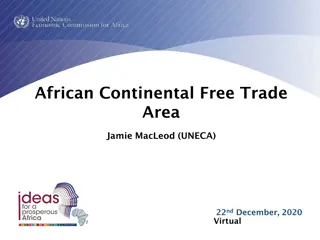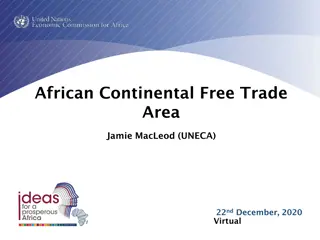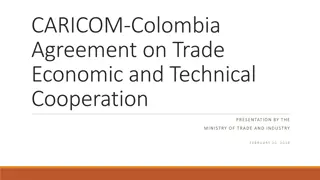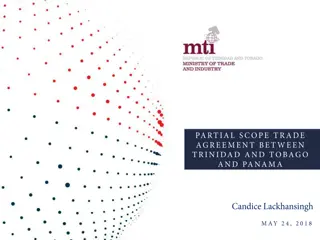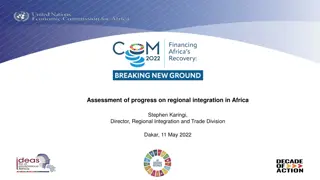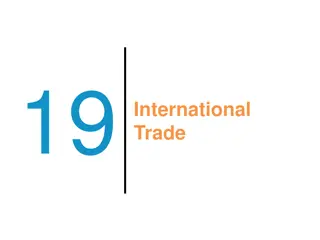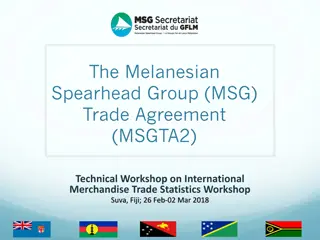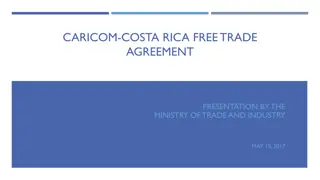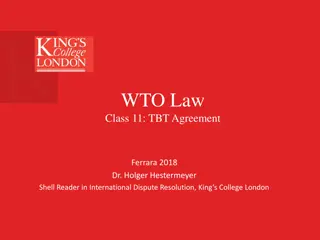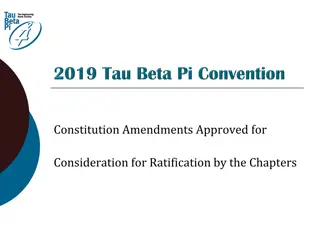AfCFTA: Ratification Agreement & Trade Strategies
In November 2018, the Agreement establishing the AfCFTA Select Committee on Trade and International Relations was ratified, outlining potential threats, mitigation strategies, implementation steps, stakeholder consultations, and the strategic importance of the AfCFTA to South Africa. The presentation covers SA's approach to trade negotiations, trade policy strategies for Africa, historical context of integration in Africa, and the objectives and features of the AfCFTA to boost intra-Africa trade.
Download Presentation

Please find below an Image/Link to download the presentation.
The content on the website is provided AS IS for your information and personal use only. It may not be sold, licensed, or shared on other websites without obtaining consent from the author.If you encounter any issues during the download, it is possible that the publisher has removed the file from their server.
You are allowed to download the files provided on this website for personal or commercial use, subject to the condition that they are used lawfully. All files are the property of their respective owners.
The content on the website is provided AS IS for your information and personal use only. It may not be sold, licensed, or shared on other websites without obtaining consent from the author.
E N D
Presentation Transcript
Ratification of the Agreement establishing the AfCFTA Select Committee on Trade and International Relations 07 November 2018
Outline of Presentation 1) 2) 3) 4) 5) 6) 7) 8) 9) 10) Potential Threats to SA 11) Mitigation of Potential Threats to SA 12) Implementation of the Agreement 13) Stakeholders Consulted 14) Concluding Observations SA approach to Trade Negotiations SA Trade Policy Strategy for Africa Integration in Africa: Historical Context and Background AfCFTA as an enabler of Intra-Africa Trade Objectives and features of the AfCFTA Legal Architecture of the AfCFTA Signature and Entry into Force of the AfCFTA Strategic Importance of the AfCFTA to SA Benefits of the AfCFTA 2 2
SA approach to Trade Negotiations Informed by/supportive of development objectives set out in NDP, NGP and IPAP. Provide opportunities to increase exports of value added products. Should not unduly limit development policy space. National consultation at intra-governmental level and in NEDLAC. SACU consultations to protect common external tariff. Focus areas: exchange of tariff concessions and related rules of origin; related legal provisions. Should support regional integration. 3 3
SA Trade Policy Strategy for Africa Africa presents opportunity to explore alternative markets: pursuit of broader regional integration through the Southern African Customs Union (SACU), the Southern African Development Community (SADC) the Tripartite Free Trade Area (T-FTA) and the African Continental Free Trade Area (AfCFTA). SA s approach to continental and regional integration is to support a development oriented integration process (market integration, infrastructure development and industrialisation). 4 4
Integration in Africa: Historical context and background Africa s commitment to economic integration as part of Pan Africanism vision. Lagos Plan of Action, 1980. Abuja Treaty Establishing African Economic Community, 1991. Boosting Intra-Africa Trade Action Plan, 2012. 8 RECs recognized by the African Union: COMESA, CENSAD, ECCAS, ECOWAS, EAC, IGAD, SADC and AMU AU Assembly launched AfCFTA negotiations at the 25th Ordinary Summit of Head of States and Governments on 15 June 2015 in Johannesburg, SA. 5 5
The AfCFTA: Boosting intra-Africa Trade (1) According to UNECA, AfCFTA promises to unlock intra-Africa trade to grow by 52% by 2022. In 2015 WTO provided a comparative analysis of intra-regional trade as follows: intra-Africa trade at 18%; intra-Asian trade at 52%; intra-North American trade at 50%; and intra-EU trade at 70%. Africa s share of world trade estimated to be at 3%. This proves that Africa needs to do more to expedite market integration. 6 6
The AfCFTA: Boosting intra-Africa Trade (3) South Africa is the largest contributor to intra-Africa trade, accounting for over 24.9% percent of intra-Africa trade, with its trade with the rest of the continent increasing by 8.6% to US$31.92 billion (R478.8 billion) in 2017. South Africa recorded a large trade surplus with the rest of Africa in 2017, exporting mainly mineral products, machinery, chemicals and iron and steel products, which accounted for over 50% of its total exports to the rest of the continent. The top African destinations in 2017 were Botswana, Namibia, Mozambique, Zambia and Zimbabwe 8 8
The AfCFTA: Boosting intra-Africa Trade (4) Country shares in total in $ Millions and % 9 9
The AfCFTA: Boosting intra-Africa Trade (5) SADC share of intra-Africa trade 55% SACU share of intra-Africa trade 43% Figure 1: RECs shares in total intra-Africa exports of goods in % 2017 in % Source: Unctadstat 10 10
Objectives and features of the AfCFTA Creation of a single market for goods and services in Africa. Expedite continental integration and enhance intra-Africa trade and investment. Harmonisation of trade regimes: progressive liberalisation of tariffs and reducing barriers to services trade. Industrial development in the AfCFTA. Recognition of different levels of development, i.e. need for Special & Differential Treatment, Flexibilities. Preservation of the acquis RECs and TFTA as building blocs. Negotiations will be amongst Member States/Regions that currently do not have preferential arrangements amongst themselves. Reciprocity. Variable geometry regarding pace of liberalisation. Establishing a single rule book for trade and investment in Africa. 12 12
Legal Architecture of AfCFTA (1) Agreement Establishing the AfCTA This is the overall Framework Agreement to which the Protocols, Annexes and Appendices form an integral part. Protocol on Trade in Goods The Protocol gives effect to the following Annexes: - - Annex 1 on the Schedule of Tariff Concessions Annex 2 on Rules of Origin, which will include an Appendix of the type of Rules to be applied. Annex 3 on Customs Cooperation and Mutual Assistance Annex 4 on Trade Facilitation Annex 5 on Non-Tariff Barriers Annex 6 on Technical Barriers to Trade Annex 7 on Sanitary and Phytosanitary Measures Annex 8 on Transit Annex 9 on Trade Remedies - - - - - - - 13 13
Legal Architecture of AfCFTA (2) Protocol on Trade in Services The Protocol includes provisions on general obligations and disciplines and progressive liberalisation. Protocol on Rules and Procedures for the Settlement of Disputes This Protocol establishes a Dispute Settlement Mechanism, which is aligned to the WTO Dispute Settlement Body. It includes the following Annexes: Schedule and Working Procedures of the Panel Expert Review Code of Conduct for Arbitrators and Panelists Phase II negotiations include Competition, Intellectual Property and Investment. Agreement envisages establishment of a secretariat. Decisions of the AU Assembly of HoS and Governments have legal force. 14 14
Signature and Entry into Force of the AfCFTA 49 members of the AU have signed the agreement. SA signed on 1 July 2018 on the margins of the 38th Session of the Ordinary Session of AU Assembly of HoS and Governments. Entry into force requires 22 member states to deposit instruments of ratification. 7 countries have ratified the AfCFTA: Kenya, Rwanda, Ghana, Niger, Chad, eSwatini and Guinea Conakry. AU Assembly of HoS and Government directed that the agreement must enter into force by Jan 2019. 15 15
Strategic Importance of AfCFTA to SA AfCFTA advances SA s regional integration aspirations and Agenda 2063. African market provides SA with alternative market for export of value added goods and services. SA s total trade with Africa amounted to R421 billion in 2017 (exports: R311 billion, imports: R109 billion). SA had a trade surplus of R202 billion. Manufactured goods amounted to 64% of SA exports to the Continent. SA s export destination is East and Southern African region, primarily SADC. AfCFTA presents an opportunity for expansion to new markets in West and North Africa. 16 16
Benefits of the AfCFTA (1) Achieving larger economies of scale, a bigger market and improved prospects for the African continent to attract investment. Potential to boost intra-Africa trade and build an integrated market in Africa, that will see a market of over 1 billion people with a combined GDP of approximately US$3.3 trillion. New export opportunities for South African products in West Africa and North Africa. The AfCFTA includes trade in services. Trade in services important for global trade, provides a backbone for industrial development. In SA, contribution of services trade to the GDP is in excess of 60%. 17 17
Benefits of the AfCFTA (2) Provides legal certainty and predictability of markets. Encourages a rules based multilateral trading system. Establishes a fair and impartial dispute resolution mechanism. Boosts intra-Africa trade through: progressive elimination of tariffs; elimination of non-tariff barriers; facilitating cooperation on customs matters, trade facilitation and transit; enhanced cooperation in the areas of technical barriers to trade and sanitary and phytosanitary measures; Stimulates Africa s industrial development and employment creation. Contributing to positive investor climate in Africa. 18 18
Potential Threats to SA Possibility of transhipment (third party imports gaining access through neighbouring countries). Influx of substandard goods. Non-implementation of commitments by regional partners with implications for preferential access for SA exports. Loss of customs revenue. Possibility of politicisation of a trade agreement. 19 19
Mitigation of Potential Threats to SA Trade Remedies (Subsidies & Countervailing Measures, Anti-dumping and Preferential Safeguard Action) *Protocol on Trade in Goods: Articles 17-19 and Annex 9 on Trade Remedies: Articles 2-5). Stringent Rules of Origin *Protocol on Trade in Goods: Article 13 and Annex 2 on Rules of Origin preventing transhipment; fostering industrialisation. Effective border management: SARS has experience in monitoring and properly classifying goods crossing border. *Protocol on Trade in Goods: Articles 14-16 and Annexes 3,4 and 8 on Customs Cooperation and Mutual Assistance, Trade Facilitation and Transit. Dispute settlement mechanism, reducing risk of politicisation.* Protocol on the Rules and Procedures for the Settlement of Disputes Capacity building and sharing of expertise among institutions. Establishing secretariat comprising of professionals and not political appointees.* Agreement establishing the AfCFTA: Article 13. 20 20
Implementation of the Agreement After entry into force of the Agreement, SARS shall introduce legislation to implement the agreed preferential treatment. Customs and Excise Act amended to: Include new tariff structure Rules of Origin and attendant certificates Import permits Tariff Rate Quotas All state parties of the AfCFTA shall introduce similar measures to afford South African exports preferential treatment. Collaboration with TISA and TIA, publicity campaigns such as roadshows to create awareness to private sector about a concluded FTA. 21 21
Stakeholders Consulted The AfCFTA negotiations are led by the dti with the support of the Department of Agriculture, Forestry and Fisheries; the South African Revenue Service; the Department of International Relations and Cooperation; as well as the Department of Justice and Constitutional Development. Where relevant, other line function Depts are consulted. Continuous engagements with NEDLAC are also undertaken in preparation and during South Africa s participation in the negotiations. Legal opinions from DIRCO and DoJ&CD approved SA s signature of the Agreement. 22 22
Concluding Observations Ratification of the Agreement - Being the most industrialised economy and the largest exporter in Africa, South Africa should avoid being an acceding member. Accession to the FTA will pose serious legal risks for SA. Market integration the AfCFTA brings us a step closer to realising the vision of an integrated market in Africa. Possibility to complement and consolidate AU work programme on infrastructure and industrial development pillars. Defending the values and principles of the multilateral trading system. Africa can achieve 52% intra-Africa by 2022. 23 23




